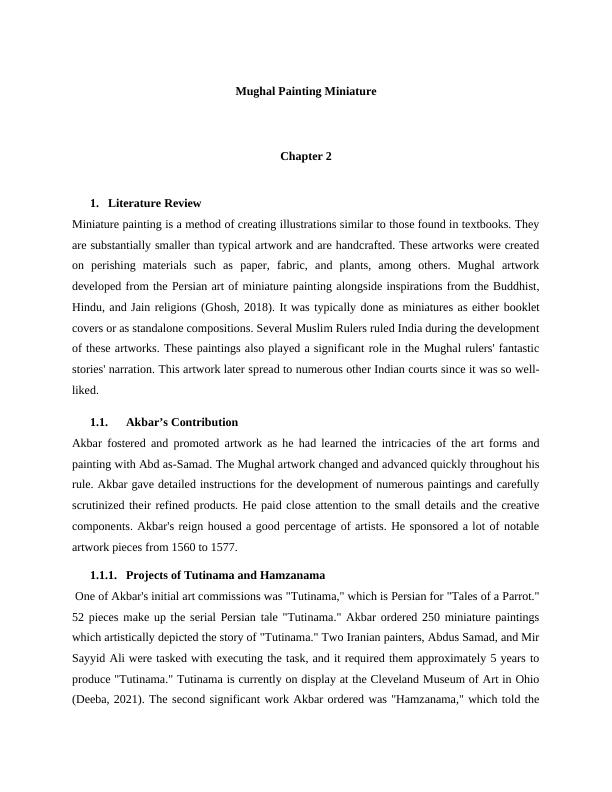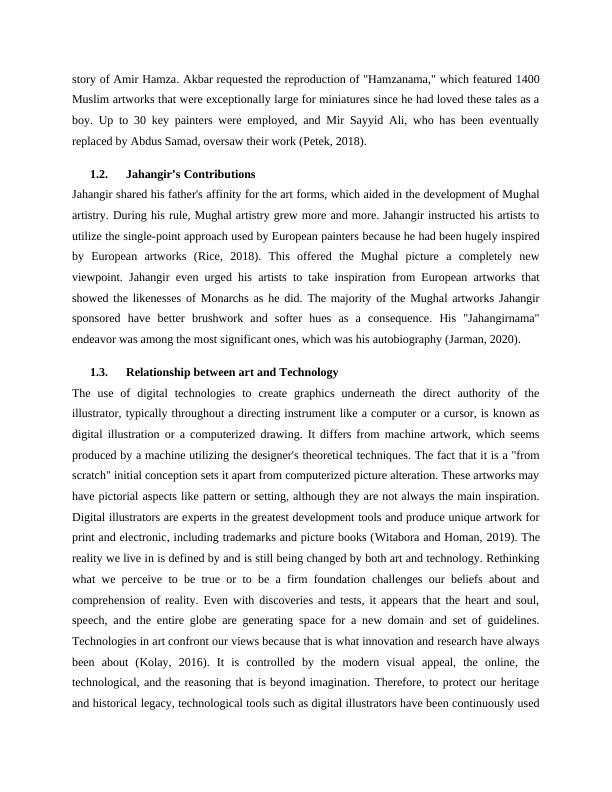Mughal Painting Miniature: History, Contributions, and Revival
5 Pages1353 Words45 Views
Added on 2023-02-02
About This Document
This article delves into the history of Mughal miniature painting, highlighting the contributions of Akbar and Jahangir. It also discusses the relationship between art and technology and the revival of Mughal miniature paintings through digital illustrations.
Mughal Painting Miniature: History, Contributions, and Revival
Added on 2023-02-02
ShareRelated Documents
Mughal Painting Miniature
Chapter 2
1. Literature Review
Miniature painting is a method of creating illustrations similar to those found in textbooks. They
are substantially smaller than typical artwork and are handcrafted. These artworks were created
on perishing materials such as paper, fabric, and plants, among others. Mughal artwork
developed from the Persian art of miniature painting alongside inspirations from the Buddhist,
Hindu, and Jain religions (Ghosh, 2018). It was typically done as miniatures as either booklet
covers or as standalone compositions. Several Muslim Rulers ruled India during the development
of these artworks. These paintings also played a significant role in the Mughal rulers' fantastic
stories' narration. This artwork later spread to numerous other Indian courts since it was so well-
liked.
1.1. Akbar’s Contribution
Akbar fostered and promoted artwork as he had learned the intricacies of the art forms and
painting with Abd as-Samad. The Mughal artwork changed and advanced quickly throughout his
rule. Akbar gave detailed instructions for the development of numerous paintings and carefully
scrutinized their refined products. He paid close attention to the small details and the creative
components. Akbar's reign housed a good percentage of artists. He sponsored a lot of notable
artwork pieces from 1560 to 1577.
1.1.1. Projects of Tutinama and Hamzanama
One of Akbar's initial art commissions was "Tutinama," which is Persian for "Tales of a Parrot."
52 pieces make up the serial Persian tale "Tutinama." Akbar ordered 250 miniature paintings
which artistically depicted the story of "Tutinama." Two Iranian painters, Abdus Samad, and Mir
Sayyid Ali were tasked with executing the task, and it required them approximately 5 years to
produce "Tutinama." Tutinama is currently on display at the Cleveland Museum of Art in Ohio
(Deeba, 2021). The second significant work Akbar ordered was "Hamzanama," which told the
Chapter 2
1. Literature Review
Miniature painting is a method of creating illustrations similar to those found in textbooks. They
are substantially smaller than typical artwork and are handcrafted. These artworks were created
on perishing materials such as paper, fabric, and plants, among others. Mughal artwork
developed from the Persian art of miniature painting alongside inspirations from the Buddhist,
Hindu, and Jain religions (Ghosh, 2018). It was typically done as miniatures as either booklet
covers or as standalone compositions. Several Muslim Rulers ruled India during the development
of these artworks. These paintings also played a significant role in the Mughal rulers' fantastic
stories' narration. This artwork later spread to numerous other Indian courts since it was so well-
liked.
1.1. Akbar’s Contribution
Akbar fostered and promoted artwork as he had learned the intricacies of the art forms and
painting with Abd as-Samad. The Mughal artwork changed and advanced quickly throughout his
rule. Akbar gave detailed instructions for the development of numerous paintings and carefully
scrutinized their refined products. He paid close attention to the small details and the creative
components. Akbar's reign housed a good percentage of artists. He sponsored a lot of notable
artwork pieces from 1560 to 1577.
1.1.1. Projects of Tutinama and Hamzanama
One of Akbar's initial art commissions was "Tutinama," which is Persian for "Tales of a Parrot."
52 pieces make up the serial Persian tale "Tutinama." Akbar ordered 250 miniature paintings
which artistically depicted the story of "Tutinama." Two Iranian painters, Abdus Samad, and Mir
Sayyid Ali were tasked with executing the task, and it required them approximately 5 years to
produce "Tutinama." Tutinama is currently on display at the Cleveland Museum of Art in Ohio
(Deeba, 2021). The second significant work Akbar ordered was "Hamzanama," which told the

story of Amir Hamza. Akbar requested the reproduction of "Hamzanama," which featured 1400
Muslim artworks that were exceptionally large for miniatures since he had loved these tales as a
boy. Up to 30 key painters were employed, and Mir Sayyid Ali, who has been eventually
replaced by Abdus Samad, oversaw their work (Petek, 2018).
1.2. Jahangir’s Contributions
Jahangir shared his father's affinity for the art forms, which aided in the development of Mughal
artistry. During his rule, Mughal artistry grew more and more. Jahangir instructed his artists to
utilize the single-point approach used by European painters because he had been hugely inspired
by European artworks (Rice, 2018). This offered the Mughal picture a completely new
viewpoint. Jahangir even urged his artists to take inspiration from European artworks that
showed the likenesses of Monarchs as he did. The majority of the Mughal artworks Jahangir
sponsored have better brushwork and softer hues as a consequence. His "Jahangirnama"
endeavor was among the most significant ones, which was his autobiography (Jarman, 2020).
1.3. Relationship between art and Technology
The use of digital technologies to create graphics underneath the direct authority of the
illustrator, typically throughout a directing instrument like a computer or a cursor, is known as
digital illustration or a computerized drawing. It differs from machine artwork, which seems
produced by a machine utilizing the designer's theoretical techniques. The fact that it is a "from
scratch" initial conception sets it apart from computerized picture alteration. These artworks may
have pictorial aspects like pattern or setting, although they are not always the main inspiration.
Digital illustrators are experts in the greatest development tools and produce unique artwork for
print and electronic, including trademarks and picture books (Witabora and Homan, 2019). The
reality we live in is defined by and is still being changed by both art and technology. Rethinking
what we perceive to be true or to be a firm foundation challenges our beliefs about and
comprehension of reality. Even with discoveries and tests, it appears that the heart and soul,
speech, and the entire globe are generating space for a new domain and set of guidelines.
Technologies in art confront our views because that is what innovation and research have always
been about (Kolay, 2016). It is controlled by the modern visual appeal, the online, the
technological, and the reasoning that is beyond imagination. Therefore, to protect our heritage
and historical legacy, technological tools such as digital illustrators have been continuously used
Muslim artworks that were exceptionally large for miniatures since he had loved these tales as a
boy. Up to 30 key painters were employed, and Mir Sayyid Ali, who has been eventually
replaced by Abdus Samad, oversaw their work (Petek, 2018).
1.2. Jahangir’s Contributions
Jahangir shared his father's affinity for the art forms, which aided in the development of Mughal
artistry. During his rule, Mughal artistry grew more and more. Jahangir instructed his artists to
utilize the single-point approach used by European painters because he had been hugely inspired
by European artworks (Rice, 2018). This offered the Mughal picture a completely new
viewpoint. Jahangir even urged his artists to take inspiration from European artworks that
showed the likenesses of Monarchs as he did. The majority of the Mughal artworks Jahangir
sponsored have better brushwork and softer hues as a consequence. His "Jahangirnama"
endeavor was among the most significant ones, which was his autobiography (Jarman, 2020).
1.3. Relationship between art and Technology
The use of digital technologies to create graphics underneath the direct authority of the
illustrator, typically throughout a directing instrument like a computer or a cursor, is known as
digital illustration or a computerized drawing. It differs from machine artwork, which seems
produced by a machine utilizing the designer's theoretical techniques. The fact that it is a "from
scratch" initial conception sets it apart from computerized picture alteration. These artworks may
have pictorial aspects like pattern or setting, although they are not always the main inspiration.
Digital illustrators are experts in the greatest development tools and produce unique artwork for
print and electronic, including trademarks and picture books (Witabora and Homan, 2019). The
reality we live in is defined by and is still being changed by both art and technology. Rethinking
what we perceive to be true or to be a firm foundation challenges our beliefs about and
comprehension of reality. Even with discoveries and tests, it appears that the heart and soul,
speech, and the entire globe are generating space for a new domain and set of guidelines.
Technologies in art confront our views because that is what innovation and research have always
been about (Kolay, 2016). It is controlled by the modern visual appeal, the online, the
technological, and the reasoning that is beyond imagination. Therefore, to protect our heritage
and historical legacy, technological tools such as digital illustrators have been continuously used

End of preview
Want to access all the pages? Upload your documents or become a member.
Related Documents
Mughal Painting Miniaturelg...
|6
|1325
|61
